When the C&C company shut down operations in 1986, it was big news in the North American boating community. Since the company’s formation in 1969, it had been a stalwart of the industry-the leading Canadian builder, by far, and one of the major brands wherever fiberglass sailboats raced or cruised.
C&C’s lineup always featured the dual-purpose racer-cruiser, and always aimed for quality construction and detail, fitting a market niche below the outstanding luxury yacht but above the standard, midline fiberglass auxiliary. C&C boats are known for good-looking moderate designs, a tradition started by the original partners-the two Cs, George Cuthbertson and George Cassian-and the companys chief designer, Rob Ball. Performance also was a C&C hallmark. Most of its models were heavily marketed as serious racers, and even old C&Cs continue to be actively raced in PHRF fleets today.
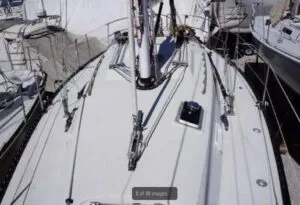
C&C was the first major company to commit to cored hull construction, and only Tillotson-Pearson compared to C&C in terms of experience with balsa-cored laminates. The builder also was the first major company to commit to solid rod rigging, and they had a tradition of rigging and equipping their boats with first-class spars and fittings.
The C&C 33 is often referred to as the new C&C 33 or the C&C 33 Mark II (33-2), to distinguish it from the C&C 33 Mark I, which was produced between 1974 and l977. While some of the specs are similar, the Mark II is an entirely different boat, not sharing any of the tooling of the Mark I. The Mark I was widely regarded as one of the prettiest racers around, and 209 of them were built.
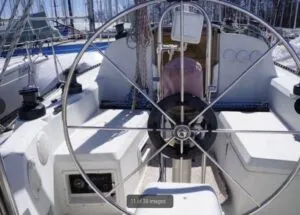
In design, the C&C 33 Mark II has conservative lines. Like other C&C models, it has a flat sheer, sharply reversed transom and sharply angled bow. The hull has a fine entry and cutaway forefoot. There’s a hard turn to the bilge about a foot below the waterline, and the very center of the hull is flat. A fin keel was standard, but a shorter fin and a keel/centerboard combination were available options. A small skeg is fitted ahead of the spade rudder. According to owners, this setup allows for precise turning in tight spaces.
The Mark II was introduced in 1984, and over 200 of them were built in the four years the boat was in production-impressive considering the company’s business problems in the middle of the run, and the heavy competition in this size from American and European companies.
CONSTRUCTION
The Mark II’s hull construction represented a departure from typical C&C practices, in that only the forward panels of the hull are balsa cored. The rest of the hull is a conventional hand lay-up of mat and roving, with an isophthalic gelcoat and skinning resin. The 33’s larger sisters (35, 38, 41, and 44) have balsa coring throughout their hulls, while the smaller sisters (30 and 27) have no coring at all in the hull.
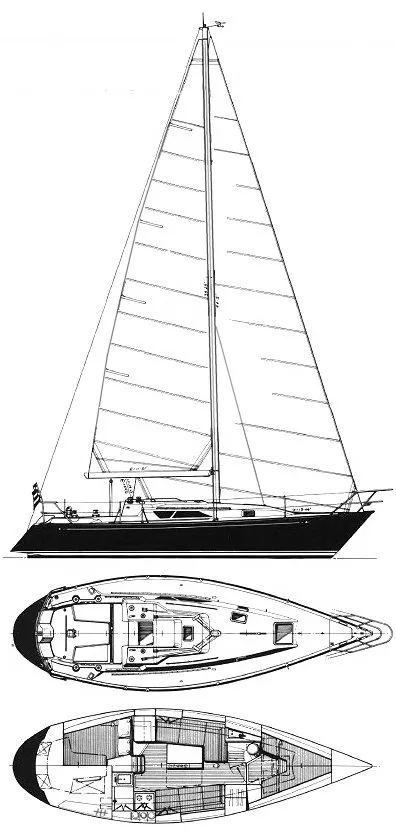
The cored laminate offered stiffness and strength combined with light weight, and it was one of C&Cs keys to building tough, lightweight race boats that wouldn’t flex too much. To achieve stiffness and strength without the coring, C&C used what they call a spider system: basically a structural framing bonded to the hull and integrated with the attachment points for the rig and keel. The hull laminate itself becomes relatively less important structurally, as the frame becomes the primary load-bearing structure of the boat.
The deck is one-piece molding with balsa core in the horizontal surfaces, and hardware is backed with both aluminum and Coremat for strength at the attachment points.
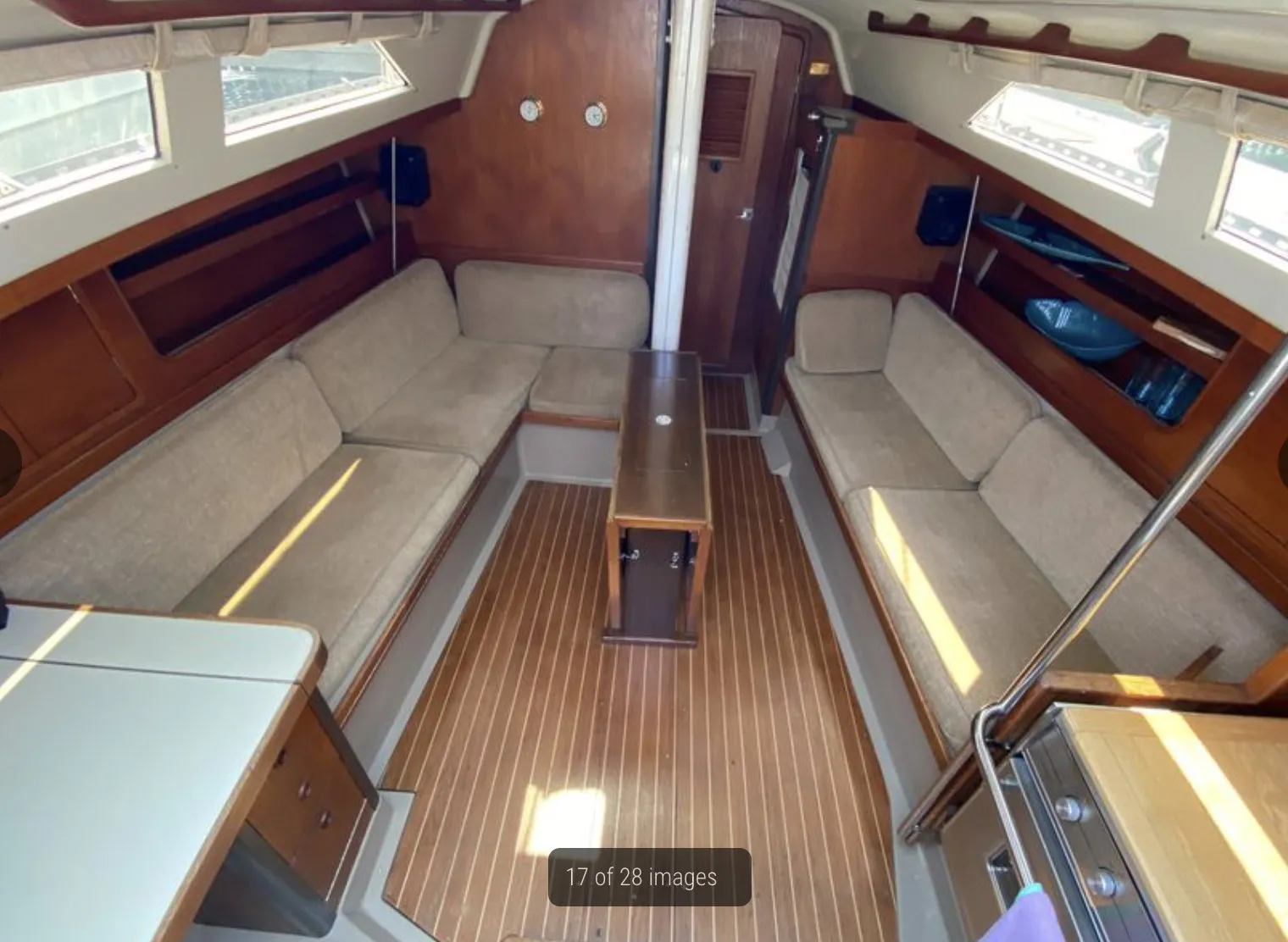
The hull-to-deck joint is standard, with an inward-turning hull flange on which the deck is set. Stainless bolts run through the joint and through an aluminum toerail that covers the joint. The whole stem fitting as well as the corner pieces for the toe rail are the heavy aluminum castings that are traditional on C&C boats, but it is interesting that C&C used plastic moldings for the stanchion bases on the 33.
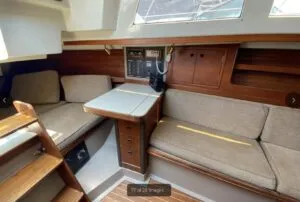
When new, the Mark IIs had good quality gelcoat and generally fair hulls. But if you’re considering buying a used one, be sure to look for signs of stress cracking or crazing as most of these have been raced a lot-some quite hard-over the last 25 years. Our reviewer examined one, built in 1988, that had only minor crazing and a surprisingly good quality deck, but the owner explained it had not been actively raced in the past.
The standard fin keel (6-ft., 4-in. draft) is external lead, bolted to a stub on the hull. The centerboard option is unusual in that it is a fiberglass molding with some lead inside, and the board is fitted entirely inside a shallow keel (4-foot, 4-inch draft) fitted to the hull.
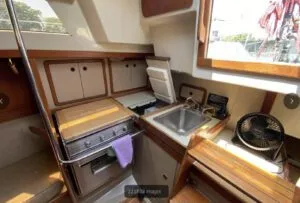
The fiberglass board is lighter (for lifting) and quieter than a more common steel board, which tends to bang around in the centerboard trunk. The fiberglass molding also makes for a better-shaped and fairer fin for upwind work. The lifting cable is housed inside the keel, so it presents no drag and makes no noise at speed. The cable passes through the cabin and is housed in a stainless-steel tube, which also supports the cabin table, and is led to a stopper and winch on the aft end of the cabin house.
The fin keel weighs 3,975 pounds (42 percent of total displacement); the keel/centerboard, at 5,258 pounds, is much heavier. Nominal displacement for the fin-keel version is 9,450 pounds; for the centerboard version, its 10,733 pounds.
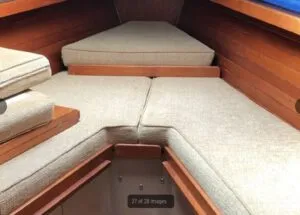
The 33s rudder is fiberglass over a webbing of stainless welded to the stainless-steel rudder stock. If you’re considering buying a C&C 33, be sure to look over the rudder and skeg carefully.
Also, as is the case with most 25-year-old, external-ballast keel boats, the ballast should be lowered and the keel bolts inspected before purchase, especially if the boat is sailed offshore. C&Cs are among the production boats (like Catalinas, Hunters, and Cals) that have been known to show a keel smile, where the keel bolts work loose and water gets in between hull and keel, causing the bolts to corrode. Usually a product of not torquing the keel bolts periodically, the keel smile is due more to a lack of proper maintenance than design.
THE RIG
The model that we sailed had a rig from the C&C spar shop, known in its time as a builder of sturdy high-performance rigs. The spars on later models were from Offshore Spars in Detroit.
The mast and boom are fairly heavy extrusions, painted white, with integral grooves for taking bolt rope or slugs. The mast came standard with internal halyards and lifts, as well as an internal wiring conduit and VHF cable. The boom has built-in slab reefing gear. The mast is stepped on the keel.
The standard standing rigging is made up of Navtec stainless rod, tangs, and turnbuckles, with 1 x 19 stainless for the adjustable babystay and for the split part of the lower backstay. Original main and jib halyards were stainless with rope tails. The shroud chainplates, set inboard for close sheeting, are attached to the hull by stainless rods between the deck and hull anchor points.
The Mark II came standard with good quality hardware for rig control. Spinnaker winches and gear, boom vang, and backstay adjuster were options.
ENGINE/MECHANICAL SYSTEMS
The original Yanmar 2GM engine is a bit tight in the 33s engine compartment, but otherwise the installation is first rate. The engine beds are actually part of the structural spider beams. The engine box is insulated with sound deadener, and the engine is about as quiet as you can expect a two-cylinder diesel to be. The standard solid prop should be replaced with a folding prop.
The electrical system and plumbing are well done. Electricity includes a 12-volt system with ample interior lighting. A 120-volt shore-power system, with a 50-foot shore cord, was standard equipment.
A three-burner, propane stove with oven also was standard, as was hot-and-cold pressurized water. The 30-gallon water tank is adequate for typical cruising, though ocean sailors may want to convert the standard 24-gallon holding tank to freshwater storage.
PERFORMANCE
The 20-horsepower Yanmar is big enough to handle the boat in most conditions. We were under power only in fairly flat water. The boat was fitted with an optional Martek folding prop, and we had no problems backing or turning. The engine pushed the boat to hull speed easily. We suspect a big head sea would challenge the peak output of the engine, probably slowing the boat to 4 knots or so, but the amount of power is ample for all reasonable sailors in almost all conditions.
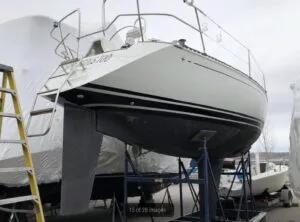
Steering is with the standard 36-inch destroyer wheel. Throttle and shift controls are integral to the pedestal, and visibility over the deckhouse is good when you are sitting on the skippers bubble hump behind the wheel.
The aluminum fuel tank holds 20 gallons, which should be good for about 180 miles of powering under normal conditions. The engine control panel is in one bay of the T-shaped cockpit. You can’t see it easily from the steering position, but thats a very minor inconvenience.
Access to the engine is through the removable companionway steps, through opening panels on both the port and starboard side of the engine, and through the cockpit seat locker.
The boat looks like it should be an all-around wholesome boat, but we initially thought of it as not particularly a standout in its size and price range. Our test sail convinced us otherwise. We found the 33-2 to be a fine sailer, just about everything we would want in its size.
The C&C 33 Mark II performs well without demanding the incessant tweaking and crew movement of so many high-performance boats. We sailed the centerboard version and evaluated a deep-keel version, and reviewers found no particular shortcomings in either’s performance.
With a good set of sails, the centerboard test boat was at least as weatherly as any boat in its PHRF division. We tried sailing the reaches and the runs with the board up and with the board down, and we could not discern any difference in speed-though as charterer, we deferred to the owners conviction that the boat was faster off the wind with the board up. The boat seemed to steer as well with the board up as with it down.
With the extra weight, the centerboard model is a little harder to push around a race course in light air, but in 15-knot winds, she had to ask no favors, and in 22-knot winds, she was a pleasure to sail compared to the other boats on the race course.
In absolute terms, we know that there are faster boats around. Most of them, unfortunately, are a pain to handle as the wind pipes up, and we wouldn’t want to sail them on some of the long, rainy slogs that we often encounter in cruising. Shorthanded, most of the faster boats are miserable. The C&C 33, in contrast, is an easy sailer, respectable in light winds, and a pleasure in heavier air.

ON DECK
The deck layout on the C&C 33 is conventional. The double lifelines with lifeline gates, pulpit, and pushpit are sturdy, well made, and came as standard equipment. The pushpit has a gate that can be fitted with stern ladder-a good idea for both the racer and cruiser.
The foredeck is quite narrow, so anchoring and headsail handling can be difficult. The sidedecks leading aft are wide because of the inboard shrouds and easy to move along.
Because of the sculpting and window shape, the cabinhouse looks low, but it is actually quite high-a difficult step up from the sidedecks or cockpit for some. Fortunately, because all the lines lead aft to the back edge of the cabin, there’s not much occasion to walk on the cabintop aft of the mast. Forward of the mast, the cabin slopes gradually into the deck, and movement is easy. However, the skylight over the head and the forward hatch are slippery stumble-makers and need an application of some nonskid tape.
Our test boat did not have a dodger, and the sculpting of the cabin house may make it difficult to design a wide one. A narrow dodger, fitting just over the companionway, would work well.
The cockpit is a conventional T-shape with a bridgedeck-mounted traveler. A cabintop-mounted traveler was an option, but there seems to be little to recommend it. The cockpit seats are comfortable for sitting but too short to lie down on. The forward part of the coaming is OK for sitting, but you’ll be inclined only to stand on the cockpit sole, aft of the bench seats. The cockpit is definitely skewed a little toward the racing side of this boat’s dual purpose, and it’s a much better cockpit underway than dockside.
Hardware is good quality and well arranged. The standard winches are of adequate size, though the boat is stiff enough to carry a heavy 150-percent genoa in 20 knots of wind, and that’s a handful for the No. 24 primaries, unless the racing crew is on board.
As is the case in most boats of the 33’s vintage, there’s not too much abovedeck storage. An anchor well forward will stow a Danforth, but everything else will have to go into the one aft locker under the starboard cockpit seat. It’s a cavernous locker, but the serious cruiser will have to devise a way to subdivide it to make it more usable. Behind the helmsman are a small locker for propane bottles and a small stowage spot for winch handles.
BELOWDECKS
The arrangements belowdecks are conventional: V-berth forward, head with shower opposite a hanging locker; port and starboard settees outboard of a saloon table; L-shaped galley; nav station at the head of a double quarterberth (well, maybe a one-and-three-quarter quarterberth). From the center bulkhead aft, the boat is wide open, which seems to us like a more sensible arrangement than the Euro compartmentalizing of the aft cabin and aft head, at least in a boat this size.
A few notable details: A decent built-in bureau in the forward cabin is a nice touch. The head compartment is a single fiberglass molding, including the wash basin-all compact, well designed, and easier to clean. The galley is quite serviceable, with a good stove and a stainless guardrail to keep you from crashing into it.
The teak overhead and bulkhead veneer contrast with the off-white hull liner. The liner is well done, with removable panels for servicing hardware fittings, wiring, and so on.
Overall, the cabin is comfortable. We’ve often heard older C&Cs rapped as leaky boats, with drips around windows and under heavily loaded deck hardware, but the boat we sailed was completely dry.
OWNER COMMENTS
The biggest complaints among the C&C 33 Mark II owners Practical Sailor surveyed were engine access and cabin ventilation. Nearly all noted that it was a challenge to access the engine easily, and most reported that their boat upgrades included increasing belowdecks ventilation with solar vents or other openings.
Interestingly, most gave the boat an average rating for stability but rated the seaworthiness as good or better. The majority of those surveyed rated the boats upwind and off-the-wind performance equally good; only a handful said the upwind performance was better.
Some things to keep in mind if you’re shopping for a C&C 33: Check for leaks around the chainplates and look for stress cracking in the deck, signs the boat had a hard racing life and the backstay likely saw too much pressure. A few surveyed owners reported blisters, but both said the problem was minor. One owner cautioned others to check the transmission shaft cable as his was not installed and adjusted properly, resulting in premature clutch failure.
CONCLUSIONS
If youre entirely devoted to racing, we’d probably suggest looking at something different-maybe a J/33, or possibly a J/35. For those who solely cruise, we’d also recommend different boats-maybe something more like a Tartan 34 or a Mason 33. But if you plan to do a good share of racing, some serious weekending, and at least one long, shorthanded cruise per season, then the C&C 33 is among the boats we suggest checking out. Although in some ways, it seems plain and indistinctive, the C&C 33 is admirably suited to be both a racer and a cruiser. It’s a boat for sailors who truly want a racer-cruiser. C&Cs also hold their value well, so buying one would be a sound investment, and there are plenty in good condition to be had on the resale market, especially in Canada.
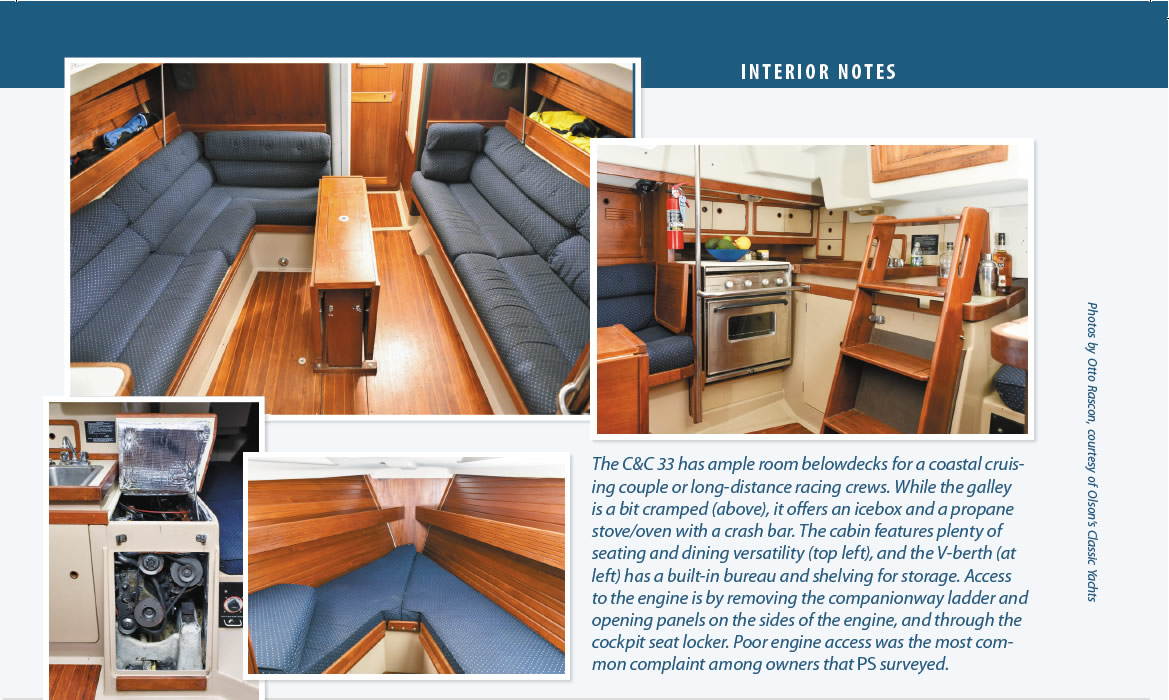

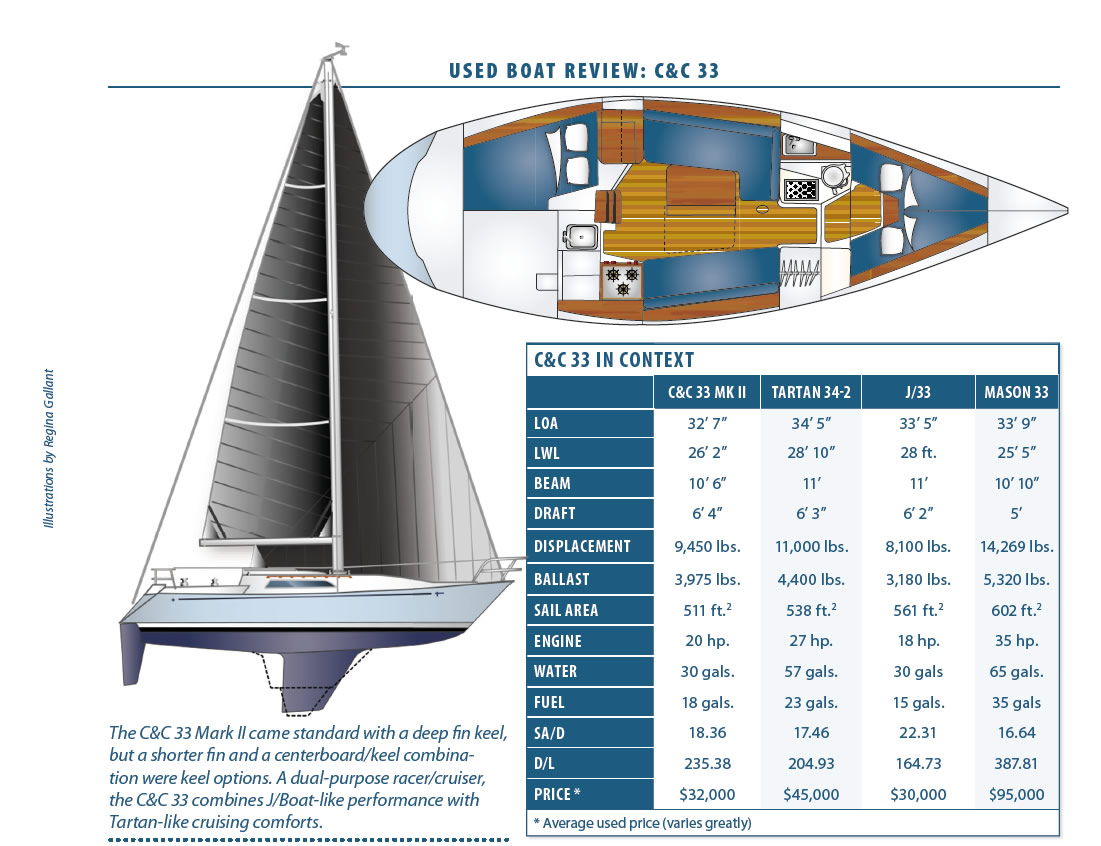
This review was published August 13, 2015 and has been updated.
































